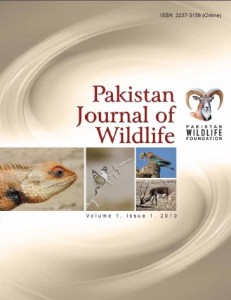|
|
Front TitleBack TitleInstructions to ContributorsEditorialEditor PageContents
Khan, W. A., Akhtar, M., Ahmad, S. A., Abid, M., Ali H. and Yaqub, A. 2010. Historical and Current Distribution of Smooth-coated otter (Lutrogale perspicillata sindica) in Sindh, Pakistan.
The study was conducted from October 2008 to September 2010 to record the historical and current distribution of smooth-coated otter (Lutrogale perspicillata sindica) in Sindh province of Pakistan. Surveys were conducted jointly by professional staff from Sindh Wildlife Department and WWF-Pakistan. An extensive literature review was carried out to explore the historic distribution of the species in Sindh. For recording the current distribution, different direct and indirect methods including direct observation, observing tracks, holts, spraints and feeding remains were applied. Local people were interviewed using a pre-tested questionnaire. Around 5000 km were traversed covering 36 different sites in 12 districts of Sindh and the existence of smoothcoated otter was confirmed at 25 sites in 11 districts. Both the historical and current distribution of the species was plotted on maps using GIS tools. The results showed that the species existed in isolated populations and in fragmented habitats in its type locality where it was once distributed evenly and all along the Indus River and irrigation system.
Abbasi, N. A., Mahmood, S., Ali, S., Qureshi, N. A. and Rais, M. 2010. Population density of Kashmir flying squirrel (Hylopetes fimbriatus) at Dhir Kot District Bagh, Azad Jammu and Kashmir.
The study was conducted to estimate the population of the small Kashmir flying squirrel in the district Bagh. The study area was divided into two sampling sites depending upon the vegetation and overall climatic variation. Surveys were conducted in the study area from October 2008 to June 2009. Line transect method was used to estimate the population of Kashmir flying squirrel. Each site was visited twice in a month. Transects were randomly selected in each study site and observations were recorded while walking through transects.
Population density was estimated as 2.28 per hectare. Population density of at site A (1370-1690 m) was estimated to be 2.23 per hectare whereas the density at site B (1690-1980 m) was 2.33 per hectare. Maximum number of squirrels was recorded in June, 2009 (5.04 squirrels per ha) while the lowest number was recorded in February, 2008 (0.18 squirrels per ha). Density of the Kashmir flying squirrel increased in summer and declined
drastically in winter months.
Nath, B. G. and Chakrborty, A. 2010. Study of Atherosclerotic Lesions in Non-human Primates of Assam.
Atherosclerosis is a major age-related process and public health problem. Occurrence of atherosclerosis in non-human primates is not common. In the present study, aortas of 10 adult non-human primates of Assam State Zoo and Department of Forest and Environment, Government of Assam were collected and examined by Sudan IV stain for the presence of spontaneously occurring atherosclerotic lesions. The lesions recorded in two animals were fatty streaks (1) and fatty dots (1).
Nath, B. G. and Chakrborty, A. 2010. Poisoning and Mycotic Infection in Golden Langur (Trachypithecus geei) of Chakrashilla Wildlife Sanctuary, Assam.
The present study examined two carcasses of golden langur (Trachypithecus geei) of Chakrashilla Wildlife Sanctuary, Assam, received by the Department of Pathology, College of Veterinary Science, AAU, Khanapara. The diseases recorded in two animals were organochlorine insecticide poisoning and zygomycotic gastritis. In the poisoning case, organochlorine compounds were detected from liver, kidney and intestine by the State Forensic Science Laboratory, Guwahati, India. In zygomycotic gastritis, growth on the serosal surface of stomach was observed and broad, aseptated fungal hyphae could be seen in both H&E stain and PAS stain sections. The study revealed that the use of organochlorine insecticide and other pesticides on rubber plants cultivated nearer to the Sanctuary might be the cause of the diseases in those animals.
Qamar, Q. Z., Anwar, M., Dar, N. I. and Ali, U. 2010. Ethno-Botanical Study of Wild Medicinal Plants of Neelum Valley, Azad Jammu and Kashmir, Pakistan.
The study was aimed to document the medicinal plants and their traditional uses in the Neelum Valley, Azad Jammu and Kashmir, Pakistan during 2010. Neelum Valley represents phyto-geographic features of Sino-Himalayan region and is rich in natural resources. The area supports moist temperate forest, dry temperate forest, sub-alpine scrub, alpine pastures and cold deserts. Data was ere collected through direct observations during field surveys, questionnaires and interviews of local inhabitants. A total of 67 medicinal plants were identified, traditionally used for remedial measures against 32 diseases. seven plant species were commercially extracted and sold to the market. Maximum (14) plant species were used as antiseptics followed by weakness (9) and anti worm (8). Leaves of these species were used more commonly (38.46%) as compared to roots (24.36%). There was a medium level of use of maximum plant species (44%) followed by low (34%) and high (22%) level. Low income and lack of facilities increased the dependence of majority of the local communities on the available natural resources for their subsistence. Study revealed that at least 16 species were threatened locally due to habitat degradation including deforestation, livestock grazing, over-exploitation and unscientific ways of collection from their natural habitat. Information gathered would be useful for the conservation of wild
medicinal plants of the valley.
Notes on morphology, habits, ecology and distribution of short-tailed ground agama; Brachysaura minor (Hardwicke and Gray 1827).
Peculiar morphology of Brachysaura minor makes it a lizard of zoological interest. It has been reported
from some localities falling in barren, stony and scrubby arid fields in subtropical temperate, Indo-Gangetic
landscape across the plains of India and Pakistan. The biotope houses several other sympatric species of
agamids, whip-tail sand-lizards, geckos and snakes. Present report sums up data gleaned from earlier reports
and adding fresh observations on morphology, habits, ecology and distribution of B. minor.
|

